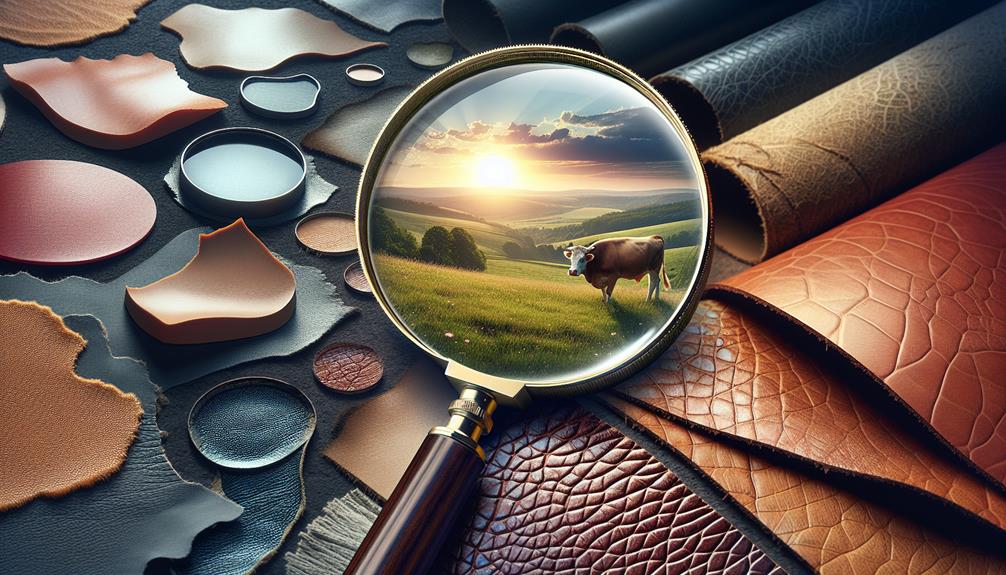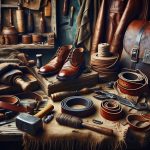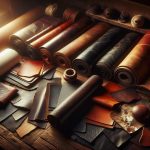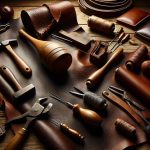Yes, when I see a product labeled "100% leather," it really means it's made from genuine animal hide. It's a sign of quality and durability because these products usually have natural imperfections, which are authentic indicators of real leather. They also become more supple and develop a patina over time. The key is to verify whether it's full-grain or top-grain leather — these are the highest quality types. You should watch out for labels and other signs like the unique leather smell and texture to ensure you're getting the real deal. There's more to learn about how these labels and qualities impact the value.
Table of Contents
Key Takeaways
- 100% leather is made from genuine animal hide, confirming its authenticity.
- It includes types such as full-grain and top grain, which signify higher quality.
- Natural imperfections in 100% leather indicate its realness and uniqueness.
- Products labeled as 100% leather offer durability and long-term quality.
- Real leather has a distinct, rich smell and a naturally textured surface.
Understanding 100% Leather
When we talk about 100% leather, we're referring to products made entirely from real animal hide, not synthetic materials. This means when I choose a jacket or a bag labeled as 100% leather, I'm getting the genuine deal. It's all about authenticity and ensuring that what I'm investing in holds up over time, both in style and function.
Opting for 100% leather also means accepting its natural imperfections. These aren't flaws, though; they're like unique signatures. Each mark tells a story—maybe a small scar or a wrinkle—that differentiates real leather from its artificial counterparts. It's this character that adds to the quality of the product, making each piece one-of-a-kind.
I'm always on the lookout for real leather because it promises durability. Unlike synthetic materials that might crack or peel after a few uses, genuine leather ages beautifully, getting richer and more supple with use. So, when I invest in a 100% leather item, I'm not just buying something to use now; I'm choosing quality that will accompany me for years, growing more distinguished with every wear.
Types of Leather Materials
Now let's explore the different types of leather materials available on the market. Understanding these can really help you make better choices when shopping for leather goods.
Starting with the cream of the crop, full grain leather is top-notch. It's the most durable type you can find because it includes the entire thickness of the animal hide. This means it retains all the natural markings, which many consider adding unique character and beauty.
Next up is top grain leather. It's still high quality but not quite the same league as full grain. The surface has been sanded down to get rid of imperfections, giving it a more uniform look. However, it does still showcase some of the leather's natural grains.
Then there's genuine leather. Don't let the name fool you; it's actually on the lower end of the leather quality spectrum. It might contain a mix of leather scraps and binders, or it could be made from the lower layers of the hide after the top is split off.
Lastly, there's faux leather, a synthetic alternative that doesn't use animal hide at all. It's vegan-friendly and can look convincingly like real leather, but it doesn't offer the same durability or feel.
Verifying Real Leather Products
When I'm out shopping for leather goods, I always look out for a few key things to make sure I'm getting the real deal.
It's important to check for labels that mention specific types of leather like full-grain or top grain, and I also look for natural imperfections which are a good sign of genuine leather.
You can usually spot fake leather by its overly uniform texture and lack of a distinct leather smell.
Identifying Genuine Leather
To spot a real leather product, check for labels like 100% leather, full-grain, top grain, or genuine leather. Full-grain leather keeps all its natural marks, telling you it's top-notch in quality.
Top grain leather, while still high quality, is a bit more processed to remove imperfections and has a smoother finish. If you're looking at genuine leather, you might notice it has an artificial grain added to it, giving it a more uniform appearance, but it's not as premium as full-grain or top grain.
When you're holding a leather item, look closely; natural imperfections are a good sign. They aren't flaws, but authentic indicators that you're getting the real deal.
Leather Quality Indicators
Identifying real leather involves scrutinizing labels and noting the material's natural imperfections. When shopping for real leather furniture, it's crucial to understand leather quality indicators. Labels like 100% leather, full-grain, or top-grain leather suggest higher quality. Full-grain leather, keeping its natural marks, often feels more authentic. In contrast, top-grain leather, though still real, is smoother due to sanding and finishing processes.
Here's a quick guide:
| Leather Type | Characteristics |
|---|---|
| Full-Grain Leather | Natural marks, highest quality |
| Top-Grain Leather | Sanded, finished, slightly lower quality |
| Genuine Leather | Artificial grain, more uniform |
| Bonded Leather | Composed of leather scraps, least natural |
| 100% Leather | Ensure no mix with other materials |
Understanding these differences helps in making an informed choice, avoiding the pitfalls of bonded leather and appreciating the value of grain leathers.
Common Imitation Signs
Let's dive into recognizing common signs of imitation to ensure you're getting real leather products. Genuine leather, like full-grain and top grain leather, often features natural imperfections. These can include blemishes and an uneven texture, which actually highlight the quality and authenticity of the material. Full-grain leather retains these marks, enhancing its unique character. In contrast, top grain leather, while still high quality, is sanded down for a smoother, more consistent finish.
Beware of bonded leather though; it's the giveaway. This type lacks any natural imperfections due to its manufacturing from scraps. It's markedly cheaper, but don't be fooled—its uniform surface is a clear sign it's not real leather. Prioritize genuine materials for true quality and craftsmanship.
Sensory Tests for Leather
You can often tell real leather from fake by simply pressing on it and noting how it wrinkles and responds. When I press my finger into actual leather, it usually shows a natural, irregular pattern of wrinkles, which isn't the case with synthetic leather. This simple test can tell you a lot about the quality and authenticity of a piece.
Let's talk about how to tell if furniture or other items are upholstered with real leather. First, look at the surface closely. Real leather has a unique texture with pores and slight imperfections, which add to its charm. On the other hand, synthetic options often look too perfect or uniform.
The smell of real leather is also quite distinctive. It has a rich, organic scent that synthetic materials can't replicate. If you're sniffing around for high quality, don't ignore your nose—it's a powerful tool for identifying genuine materials.
Here's a quick table to help you remember these points:
| Test | Real Leather | Synthetic Leather |
|---|---|---|
| Touch | Soft, supple | Often stiffer |
| Smell | Natural, rich | Chemical-like |
| Wrinkle | Natural pattern | Less pronounced |
| Texture | Visible pores | More uniform |
| Warmth | Warms quickly | Stays cool longer |
Next time you're shopping, use these sensory tests to guide your choices.
Durability of 100% Leather
When it comes to long-lasting materials, 100% leather stands out for its remarkable durability. I've noticed that items crafted from genuine leather, sourced from animal hides such as cow or buffalo, naturally endure far longer than their synthetic counterparts. This resilience to wear and tear isn't just a claim; it's a proven quality that keeps leather goods in top-notch condition for years.
The durability of 100% leather is also evident in its resistance to daily stresses. Whether it's a leather jacket, a sofa, or boots, these items don't just survive the rigors of daily use; they often get better with age. The development of a patina adds a unique character to leather products, enhancing their aesthetic appeal over time. This isn't something you can expect from faux leather or bonded leather, which tend to degrade and peel off under similar conditions.
Investing in 100% leather means opting for quality that pays back over time. The initial cost might be higher, but the long-lasting nature of genuine leather ensures that it's more than worth it. It's not just about durability; it's about owning something that gets uniquely better with age.
Ethical Considerations
When we talk about ethical considerations in leather production, it's important to consider the impact on animal welfare. Sustainable sourcing practices and the use of vegan leather alternatives are ways we can address these concerns.
Exploring these options helps us minimize the environmental and ethical issues associated with traditional leather production.
Animal Welfare Impact
Leather production raises significant ethical concerns due to the treatment of animals involved in the process. The truth is, the industry often uses hides from cows, buffaloes, and even exotic animals like crocodiles. This raises major animal welfare concerns. The way these creatures are raised and slaughtered, just for their skins, points to some pretty inhumane practices.
As someone who cares about these issues, I've learned that opting for alternative materials like vegan leather can help. It's about not supporting the harsh treatment of animals. Also, if you're going for real leather, it's crucial to choose brands that are upfront about their supply chain. Ethical leather sourcing means they stick to high animal welfare standards, which makes a big difference.
Sustainable Sourcing Practices
In addition to the ethical treatment of animals, I also focus on how leather is sourced to ensure it respects both people and the planet. Sustainable sourcing practices are vital for minimizing the environmental impact of leather production. I look for brands that use by-products from the food industry, effectively reducing waste. It's essential that these practices also consider the fair treatment of workers and support animal welfare.
Certification programs, like the Leather Working Group, are key because they promote transparency and responsible practices. By supporting these efforts, I ensure that the leather products I choose don't contribute to harmful chemicals, excessive water use, or loss of biodiversity. It's about making conscious choices that align with ethical considerations.
Vegan Leather Alternatives
As an alternative to traditional leather, vegan leather offers a cruelty-free option that still captures the aesthetic appeal of real leather. Often referred to as faux or synthetic leather, it's made from materials like polyurethane or polyvinyl chloride.
This makes it more environmentally friendly, avoiding the use of animal products and reducing the environmental impact associated with traditional leather production. Vegan leather can mirror real leather's look and feel, providing a range of colors, textures, and finishes. Its quality varies, but some types are quite durable.
Ethical considerations, like prioritizing animal welfare and sustainability, drive its popularity. It's a top choice for those who value ethical fashion and want to make responsible purchasing decisions.
Maintenance of Leather Goods
To keep your leather goods in top condition, you should regularly clean them with a damp cloth to remove any dirt and dust. It's a simple step that makes a massive difference in maintaining the quality of your items. After cleaning, applying a leather conditioner is crucial. This helps prevent the leather from drying out and cracking, ensuring it stays supple and robust.
As for storage, always remember to store your leather goods in a cool, dry place. Direct sunlight can cause the leather to fade, so avoid places like sunny windowsills or the backseat of your car. Also, keep leather away from extreme temperatures and moisture to prevent any damage.
If you're looking at keeping your leather in pristine condition, consider a professional cleaning every once in a while. They can do a deep clean and restore your items almost back to their original state if they've been particularly worn or soiled. Trust me, it's worth investing in professional help to keep your favorite leather goods looking great for years. This way, you maintain not only the appearance but also the overall quality of your leather items.
Frequently Asked Questions
How Long Does 100% Leather Last?
I've found that 100% leather can last decades if properly maintained. Its durability really depends on how you use and care for it, and quality leather pieces develop a beautiful patina over time.
Is 100% Cow Leather Good?
Yes, I think 100% cow leather is great! It's durable, looks authentic, and ages beautifully. Plus, it's strong enough to withstand daily use, making it ideal for high-quality leather goods.
What Does 100 Synthetic Leather Mean?
I've learned that 100% synthetic leather means it's completely man-made, using materials like PVC or PU, offering a cruelty-free alternative to real leather with a variety of colors and textures available.
What Does 100 Leather Furniture Mean?
I've learned that 100% leather furniture means it's all real leather, no synthetics added. It's more durable and luxurious, giving a unique, natural feel and often costing more due to its high quality.
- What Types of Clothing Are Nylon? - April 19, 2024
- What Are the 5 Types of Nylon? - April 19, 2024
- What Are the Characteristics of Nylon Fabric? - April 19, 2024








